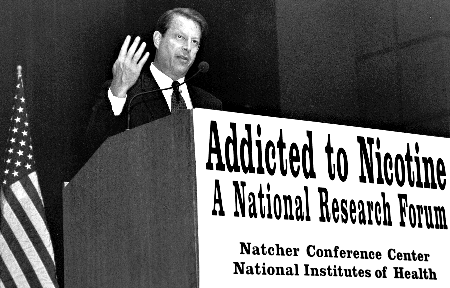Provocative new research findings about the nicotine addiction process, how nicotine addiction drives tobacco use, and nicotine addiction treatment were the focus of "Addicted to Nicotine: A National Research Forum," held in Bethesda, Maryland in July. The meeting was sponsored by NIDA and The Robert Wood Johnson Foundation and cosponsored by the National Cancer Institute and the Office on Smoking and Health of the Centers for Disease Control and Prevention. NIDA Associate Director Dr. Timothy P. Condon and Dr. Jaylan Turkkan, Chief of NIDA's Behavioral Sciences Research Branch, served as cochairs of the conference planning committee.
 In his keynote address at NIDA's nicotine conference, Vice President Al Gore tells participants that 3,000 young people start smoking each day, ultimately resulting in death for one-third of them.
In his keynote address at NIDA's nicotine conference, Vice President Al Gore tells participants that 3,000 young people start smoking each day, ultimately resulting in death for one-third of them. Keynote speaker Vice President Al Gore noted that the conference had drawn some of the world's best researchers "to reinforce that nicotine is a drug - a dangerous, highly addictive drug, and we should treat it as a drug." He cited recent research findings indicating that while the overall incidence of smoking has decreased, the number of adolescents starting to smoke has increased. "If children don't start smoking by age 19, they are unlikely to start," he said. "But, if they do start, it's hard to stop. Seventy percent of current smokers say they want to stop smoking, but can't. That's because nicotine is a highly addictive drug - as addictive as heroin or cocaine."
"We are here to apply the power of science to this problem," said NIDA Director Dr. Alan I. Leshner. He challenged the approximately 600 participants to highlight what is known about nicotine addiction and tobacco use and to "tell us what else we need to know to set the research agenda for the next decade." More than 40 scientists from the United States, Canada, and Sweden presented research results in four topic areas: the pharmacology of nicotine; individual and environmental risk factors for smoking initiation and nicotine intake; the biology of nicotine addiction; and treatment of nicotine addiction.
Dr. Jack Henningfield of The Johns Hopkins University School of Medicine in Baltimore said that, since the beginning of the 20th century, scientists have known that nicotine is a potent substance that affects the nervous system and stimulates heart rate and muscular activity, that nicotine's effects depend on the amount administered, and that responsiveness to nicotine diminishes with repeated use. NIDA-supported research has demonstrated conclusively that nicotine meets all the criteria of an addictive drug, he stressed.
Nicotine is now understood to affect the structure and function of the nervous system, Dr. Henningfield said.
Chronic nicotine exposure and withdrawal produce changes in brain function, including cerebral metabolism and hormone levels, he added.
Dr. Rachel Tyndale of the University of Toronto presented information about a gene variant for an enzyme called CYP2A6 that may protect some individuals from becoming addicted to nicotine. In humans, 60 to 80 percent of nicotine is metabolized by the CYP2A6 enzyme. Individuals with a defective version of the gene for CYP2A6 metabolize nicotine slowly and inefficiently. When people start to smoke, they often experience dizziness or nausea; when nicotine metabolism is slowed, these unpleasant effects may last longer, Dr. Tyndale explained. Thus, people with a defective version of this gene are less likely to continue smoking and, if they do smoke, are more likely to smoke less than people with a fully functioning version of this gene.
 Dr. Marina Picciotto of Yale Medical School discusses a recently identified protein that is involved in the reinforcing and rewarding aspects of nicotine addiction.
Dr. Marina Picciotto of Yale Medical School discusses a recently identified protein that is involved in the reinforcing and rewarding aspects of nicotine addiction. "This genetic defect protects approximately 7 million North Americans from smoking," said Dr. Tyndale. "Inhibiting the CYP2A6 enzyme may provide new therapeutic approaches to the prevention and treatment of smoking. The manipulation of CYP2A6 must be explored."
Dr. Marina Picciotto of Yale Medical School in New Haven, Connecticut, discussed a particular protein that she and her colleagues in France, Sweden, and Switzerland have identified as essential to the nicotine addiction process. Using sophisticated bioengineering tools, the researchers produced a strain of mice that lack this protein. They found that the genetically altered mice did not experience the normal rewarding and reinforcing aspects of nicotine that typically lead to addiction.
"The majority of smokers try to quit on their own without seeking help. The quit rate for this group is 5 percent or less," said Dr. Maxine Stitzer of The Johns Hopkins University School of Medicine, summarizing treatment research that compared the effectiveness of nicotine replacement therapy and behavioral therapy separately and combined. Because these treatments operate by different mechanisms, complementary and potentially additive effects may be expected when they are used in combination, she said.
"Typical long-term abstinence rates of 6 to 12 months for one type of therapy alone are about 20 percent," Dr. Stitzer said. "Combining therapies can produce long-term abstinence rates as high as 35 to 40 percent. We need to know how to improve access, affordability, and acceptability of both pharmacologic and behavioral therapies to take better advantage of existing treatments such as over-the-counter nicotine-replacement products. We must also learn how to strengthen the linkage between the two therapy types."
For More Information
Additional information about nicotine and its addictive properties can be obtained from NIDA Infofax and going to the Addicted to Nicotine conference information.
